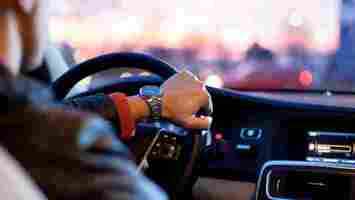UK’s new rail station tech turns your footsteps into electricity
Two walkways made from kinetic floor tiles have been installed at Leighton Buzzard train station, through a partnership between Central Bedfordshire Council and technology provider Pavegen.

As pedestrians walk across the paving system supplied by the UK start-up, the weight from their footsteps compresses electromagnetic generators below, producing electricity which will be used to power two USB-charging benches as well as a digital screen.
Funded by the Department of Transport through the £22.9 million (US$31.7 million) ADEPT SMART places Live Labs Programme , the pilot is understood to be the first of its type at a UK transport hub and the aim is to demonstrate the technology for other local authorities.
Andrew Selous, MP for South West Bedfordshire, said: “I like the fact that it engages people, involves exercise and it is creating clean electricity all the time. I think that connection between people and the energy being created through movement is a really good join-up.”
The digital screen will show how much energy is being generated as well as displaying other messages.
Pavegen is also working alongside Central Bedfordshire Council to offer commuters rewards via an app. This could be used to incentivize public transport use or local shopping to aid economic recovery, for example.
Renewable energy
In 2019, Central Bedfordshire Council secured £1.05 million through Live Labs to explore how to harvest renewable energy from solar, kinetic and thermal sources. At scale, the energy could be used to power infrastructure such as streetlights and electronic road signs.
Giles Perkins, Live Labs Programme Director, said: “The untapped footfall energy at our transport hubs represents a real opportunity to provide sustainable energy sources to power bespoke applications, while engaging audiences and encouraging behavioural change. This trial will help demonstrate the viability of the technology and could be a step change in the way transport hubs engage with commuters.”
Another pilot which explores how probes inserted into a Bedfordshire car park can generate geothermal energy is due to be completed later this month. It will show how this energy can be stored and released when necessary to de-ice a car park surface and heat a building in the winter. The trial aims to help the council understand if and how the technology could be applied in new buildings such as leisure centres and schools. A further initiative looks at capturing solar energy from road surfaces.
Pavegen has around 200 deployments across 36 different countries, including applications for cities, transport hubs, retail, interactive education and commercial brands. The V3 tiles produce up to four joules of off-grid electrical energy per step.
A spokesperson for Pavegen told Cities Today it is difficult to say what the energy output at the train station is likely to be as it is dependent on footfall, which is unpredictable due to Covid-19. “The benefit is really about how the community can come together and this product can be used as a starting point for a conversation about sustainability,” they said.
In total there are eight local-authority-led Live Labs which are piloting technology across energy, data, materials and mobility. Others are evaluating plastic roads, video analytics and data-driven transport management.
Do EVs excite your electrons? Do ebikes get your wheels spinning? Do self-driving cars get you all charged up?
Then you need the weekly SHIFT newsletter in your life. Click here to sign up .
Biden might invoke a Cold War-era act to boost domestic EV battery production
President Joe Biden is thinking about invoking the 1950 Defense Production Act (DPA) to boost US production of critical EV battery minerals.

The act grants the president emergency powers to alter domestic manufacturing policy in times of crisis.
According to Bloomberg and the Intercept , the White House is considering adding minerals such as lithium, nickel, graphite, cobalt, and manganese to the list of items covered by the act.
Passed during the Cold War era, the DPA was first used by president Harry Truman in 1950 to make steel for the Korean War. It was most recently invoked in by Donald Trump, in 2020, to increase mask production during the pandemic , and last year by Biden to expand vaccination efforts .
Now, rising gas prices and supply chain challenges — especially following Russia’s invasion of Ukraine — have made the president consider re-invoking the act.
This push also comes as several senators sent Biden a letter asking him to make use of executive powers, such as the DPA, to make the US less dependent on oil drilling abroad and support the country’s climate goals.
In a separate letter seen by Bloomberg , another group of senators urged Biden to accelerate EV battery production and reduce the country’s dependence on China for the processing of minerals and raw materials.
As per the letter:
In fact, the number of mineral commodities for which the US relies on imports — to meet more than a quarter of demand — has increased from 21 in 1954 to 58 in 2021, according to the White House’s June report on the national supply chain.
The move would open up federal funds for US mining companies that produce the materials — estimated at $750 million.
Instead of loans or direct purchases for minerals, the funds would target feasibility studies, production at existing operations, or new advancements to improve productivity or safety.
The draft of the executive order currently remains in a “pre-decisional phase,” awaiting for Congress approval.
If the act is passed, it’ll signal Biden’s most aggressive step to shift the country towards electric vehicles, followed by the infrastructure bill’s $174 billion investment in EVs , and the target for zero-emission vehicles to reach 50% in nationwide sales by 2030.
Why Uber’s supreme court battle won’t solve its drivers’ biggest problem
The UK supreme court has just heard an appeal from Uber that has far-reaching implications for UK drivers and the wider gig economy. Uber wants to overturn an employment tribunal ruling from 2016 , which improved the lot of its drivers by classifying them as “workers” instead of “self-employed contractors.”

If upheld, many Uber drivers can look forward to an hourly minimum wage, paid breaks, sick pay and holiday pay, and an average £12,000 in compensation for their past work – all provided they lodge a claim.
Drivers with other companies won’t automatically benefit from the ruling, though it will create a strong precedent for similar claims. The 2017 Taylor review of modern working practices highlighted the need to “be clearer about how to distinguish workers from those who are legitimately self-employed” as one of its “seven steps towards fair and decent work.”
Uber last challenged the ruling in the court of appeal in 2018, but lost the case . If it loses in the supreme court, the original tribunal finding should be implemented.
Driving precariously
Many taxi drivers are in a very precarious position in their work, as both my research team and others have shown . Uber controls fares, aiming to be significantly cheaper than its competitors, and takes a 25% commission, which limits drivers’ earnings per mile. Our research suggests that after purchasing, maintaining, and running their vehicle, some Uber drivers in England earn as little as £5 an hour.
Some of our industry participants suggested that Uber has contributed to a systematic oversupply of drivers by attempting to ensure a driver is available whenever required. Local private-hire competitors have adopted some of the American company’s practices, such as offering bookings via an app, although their relationship with drivers was described to us as less impersonal. Other international private-hire platforms like Ola , Bolt , and Kapten are also entering the British market.
We found indications that the increasing number of drivers has combined with low earnings to lead some private-hire drivers to illegally “ply for hire:” they pick up fares without a pre-booking, which invalidates their insurance. This increases competition for Hackney drivers, some of whom said they now work significantly longer hours to survive. Forcing Uber to guarantee an hourly minimum wage may help by removing its incentive to recruit so many drivers.
Beyond the immediate implications of the ruling, re-designating drivers as workers would send a message that operators share some responsibility for drivers’ wellbeing. This particularly matters during the pandemic: male taxi drivers and chauffeurs in England and Wales are among those most severely affected by COVID-19, dying at over three times the average rate.
Drivers were permitted to work during the lockdown and played an important role in transporting key workers and patients. Yet it was left to local authorities and operators to set any rules around drivers and passengers wearing personal protective equipment .
Requirements for wearing masks on public transport do not apply to private hire cars or Hackneys in England, unlike in Scotland. Drivers can refuse passengers without masks, but risk receiving a poor app rating or complaints to the operator, jeopardizing future work.
Due to their self-employed status, drivers only became entitled to government financial support from June, several months after employees. Even then, there have been suggestions that many still don’t qualify – for example, if they derive less than half their income from self-employment or became self-employed after April 6.
The only institutions that acknowledge responsibility for drivers’ welfare are their trade unions, associations, and cooperatives. Significantly, the legal challenge to Uber involves several trade unions, rather than being led by parliament, councils, or operators.
Beyond the supreme court
Even if the supreme court rules in favor of workers – the decision is due in a few weeks – other factors that make drivers’ lives precarious still need to be addressed. Uber is facing a separate new action over its algorithm, with drivers complaining that there is little transparency about how it collects data about their work and uses it for things like allocating jobs.
Legislation governing the sector is also widely regarded as outdated, since it long pre-dates the Uber era, and is slowly being reformed . The sector was deregulated in 2015 to allow private-hire drivers registered in one local authority to operate anywhere in England and Wales. Our research suggests this has contributed to the over-supply of drivers in some areas since they can obtain a cheaper license with fewer restrictions from another local authority and use it to work anywhere.
This has encouraged divisions among drivers and made it more complicated for local authorities to enforce their taxi rules since they have to liaise with the local authority that issued the license. This could be addressed by changing the law to limit private-hire drivers to the licensing local authority. If local authorities could also cap the number of licensed private-hire vehicles in their area, as is already the case in Scotland, this could make a big difference to the over-supply.
Such measures carry risks, however. Some of our research participants suggested that working as a private-hire driver was the last resort for some people, so any licensing restrictions would need combined with creating alternative work opportunities and support to help people change careers.
Finally, the legislation imposes conditions aimed at protecting passengers’ safety and welfare, and this could be extended to include drivers’ welfare. For example, it could enable them to complain officially over unfair treatment as part of their licensing conditions. Indeed, if drivers are overworked, underpaid, and stressed, this has clear negative implications for passengers, so this is really part of protecting their welfare too.
This article is republished from The Conversation by Tom Vickers , Senior Lecturer in Sociology, Nottingham Trent University under a Creative Commons license. Read the original article .
SHIFT is brought to you by Polestar. It’s time to accelerate the shift to sustainable mobility. That is why Polestar combines electric driving with cutting-edge design and thrilling performance. Find out how .